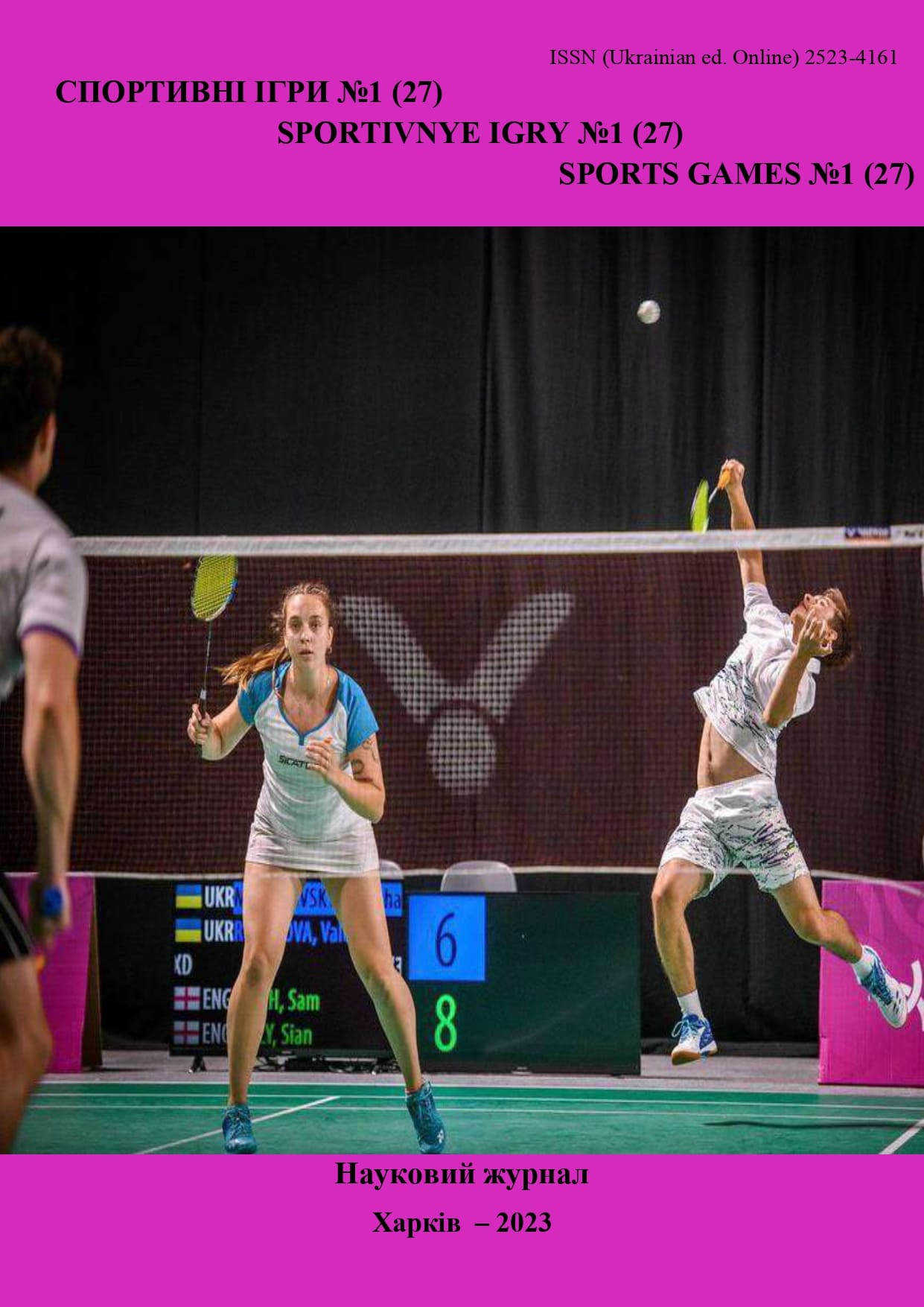Model morphofunctional indicators of highly qualified volleyball players
DOI:
https://doi.org/10.15391/si.2023-1.10Keywords:
fat component, muscle component, bone mass, water contentAbstract
The purpose of the study was to determine the model indicators of the body composition highly qualified volleyball players of the Ukrainian Super League. Material and methods. 13 volleyball players with the qualification of master of sports, candidate for master of sports, who were part of the team of VC "MHP-Vinnytsia" participating in the Championship of Ukraine among men's teams of the Super League, took part in the study. Using the method of anthropometry, we determined the body length of the studied players using a standard height meter. Morphofunctional diagnostics involved determining the body composition of volleyball players using the Tanita BC-601 body composition monitor. The morphofunctional profile of volleyball players included the following indicators: body weight (kg) and body mass index (kg/m2); fat component content (%); muscle component content (kg); bone component content (kg); body water content (%). Results. The age of the studied volleyball players was 21.92±1.21 years, the average height of the players was 1.98±0.02 m, body weight - 90.49±3.42 kg, body mass index - 23.06±0.71 kg/m2, the total content of the fat component in the body was 11.42±1.11 %, the total content of the muscle component was 76.10±2.24 kg, the total water content in the body of volleyball players was 63.06±0.78 % , bone mass – 3.90±0.11 kg. Conclusions. 18 indicators were determined that characterize the stature and body composition of highly qualified volleyball players of the Ukrainian Super League. The analysis of the obtained data showed a slight asymmetry in the distribution of fat and muscle components in the legs and arms of the athletes, related to the nature of the volleyball game. Since highly qualified athletes are considered ideal models in the chosen sport, the obtained indicators of the body composition can be characterized as model and serve as a reference point for assessing the prospects of young people.
References
Гончаренко, В.І. (2019). Фізична та функціональна підготовленість висококваліфікованих спортсменок різних ігрових амплуа в хокеї на траві. Вісник Луганського національного університету імені Тараса Шевченка: педагогічні науки, 4 (327), 143–155.
Дорошенко, Е.Ю. (2014). Теоретико-методичні основи управління техніко-тактичною діяльністю в командних спортивних іграх: автореф. дис. ... докт. наук з фіз. вих. і спорту: спец. 24.00.01 «Олімпійський і професійний спорт». Київ.
Костюкевич, В.М. (2018). Теоретико-методичні основи управління процесом підготовки спортсменів різної кваліфікації: колект. моногр. Вінниця: Планер.
Щепотіна, Н. (2021). Морфофункціональний профіль кваліфікованих волейболістів. Фізична культура, спорт та здоров’я нації, 11 (30), 252-259. DOI: 10.31652/2071-5285-2021-11(30)-252-259.
Щепотіна, Н.Ю. (2016). Побудова мікроциклів підготовки кваліфікованих волейболісток на основі модельних тренувальних завдань. Науковий часопис Національного педагогічного університету імені М.П. Драгоманова. Серія № 15. «Науково-педагогічні проблеми фізичної культури». К. : Вид-во НПУ імені М. П. Драгоманова, 3К 1 (70) 16, 239 – 243.
Щепотіна, Н.Ю. (2017). Педагогічний та медико-біологічний контроль підготовленості та змагальної діяльності волейболісток різної кваліфікації. Теоретико-методичні основи контролю у фізичному вихованні та спорті: монографія; за заг. ред. В. М. Костюкевича. Вінниця ТОВ «Планер», 116–134.
Щепотіна, Н.Ю., & Якушева, Ю.І. (2013). Аналіз складу тіла висококваліфікованих волейболісток. Physical education, sport and health culture in modern society, 3(23), 102–105.
Acar, H. & Eler, N. (2019). The Relationship between Body Composition and Jumping Performance of Volleyball Players. Journal of Education and Training Studies, 7(3), 192–196. DOI: 10.11114/jets.v7i3.4047.
Aytek, A.I. (2007). Body composition of Turkish volleyball players. Intensive course in Biological Anthropology: 1st Summer School of the European Anthropological Association. 30 June, 2007, Prague, Czech Republic. Prague: EAA Summer School eBook, 203–208.
Bezmylov, M., Shynkaruk, O., Byshevets, N., Qi, G., & Zhigong, S. (2022). Morphofunctional Characteristics of Basketball Players with Different Roles as Selection Criteria at the Stage of Preparation for Higher Achievements. Teorìâ Ta Metodika Fìzičnogo Vihovannâ, 22(1), 92–100. DOI: 10.17309/tmfv.2022.1.13
Bompa, T.O., & Haff, G G. (2009). Periodization: Theory and Methodology of Training. Champaign, IL, USA: Human Kinetics.
Gardasevic, J., Bjelica, D., Vasiljevic, I., Arifi, F., & Sermaxhaj, S. (2019). Body composition of elite soccer players from Montenegro and
Kosovo. Sport Mont, 17(3), 27–31. DOI: 10.26773/smj.191011
Kostiukevych, V., Lazarenko, N., Shchepotina, N., Vozniuk, T., Shynkaruk, О., Voronova, V., Kutek, T., Konnov, S., Stasiuk, I., Poseletska, K., & Dobrynskiy, V. (2021). Factor Analysis of Special Qualities of Elite Field Hockey Players. Sport Mont, 19(S2), 41–47. DOI: 10.26773/smj.210908
Kostiukevych, V., Shchepotina, N., & Vozniuk, T. (2020). Monitoring and Analyzing of the Attacks of the Football Team. Teorìâ Ta Metodika Fìzičnogo Vihovannâ, 20(2), 68–76. DOI: 10.17309/tmfv.2020.2.02
Kozina, Zh., Sobko, I., Bazulyuk, T., Ryepko, O., & Lachno, O. (2015). The applying of the concept of individualization in sport. Journal of Physical Education and Sport, 15 (2), 172–177. DOI: 10.7752/jpes.2015.02027
Malý, T., Malá, L., Zahálka, F., Baláš, J., & Čada, M. (2011). Comparison of body composition between two elite women's volleyball teams. Acta Univ. Palacki. Olomuc., Gymn, 41(1), 15–22.
Platonov, V.N. (2006). The basis of modern training process periodization in high-performance athletes for year preparation. Research Yearbook, 12(2), 176–180.
Shchepotina, N., Kostiukevych, V., Drachuk, A., Vozniuk, T., Asauliuk, I., Dmytrenko, S., Adamchuk, V., Polishchuk, V., Romanenko, V., & Blazhko, N. (2021). Model Morpho-Functional Characteristics of Qualified Volleyball Players. Sport Mont, 19(S2), 213–217. DOI: 10.26773/smj.210936
Stech, M. (2010). The jumping action's indices of female volleyball players and their relation at some somatic characteristics. Physical Education of Students, 1, 102–105.
Stech, М., & Smulskij, V. (2008). About correlation between the somatic characteristics of different performance of women's volleyball players and ranking estimation of their sport skill level. Physical education of the student of creative specialties, 6, 105–110.
Valleser, C.W M., Bersola, K.A.R., Mallari, M.F.T., Papa, E.L.V., Diaz, F.C.B., Maghanoy, M.L.A., & Lariosa, C.J.D. (2018). Anthropometric profile of elite women’s volleyball players in the Philippines. Turkish Journal of Kinesiology, 4(2), 53–57.
Wilmore, I.H., Costill, D.L., & Kenney, L.W. (2012). Physiology of sport and exercise. Illinois: Human Kinetics.













